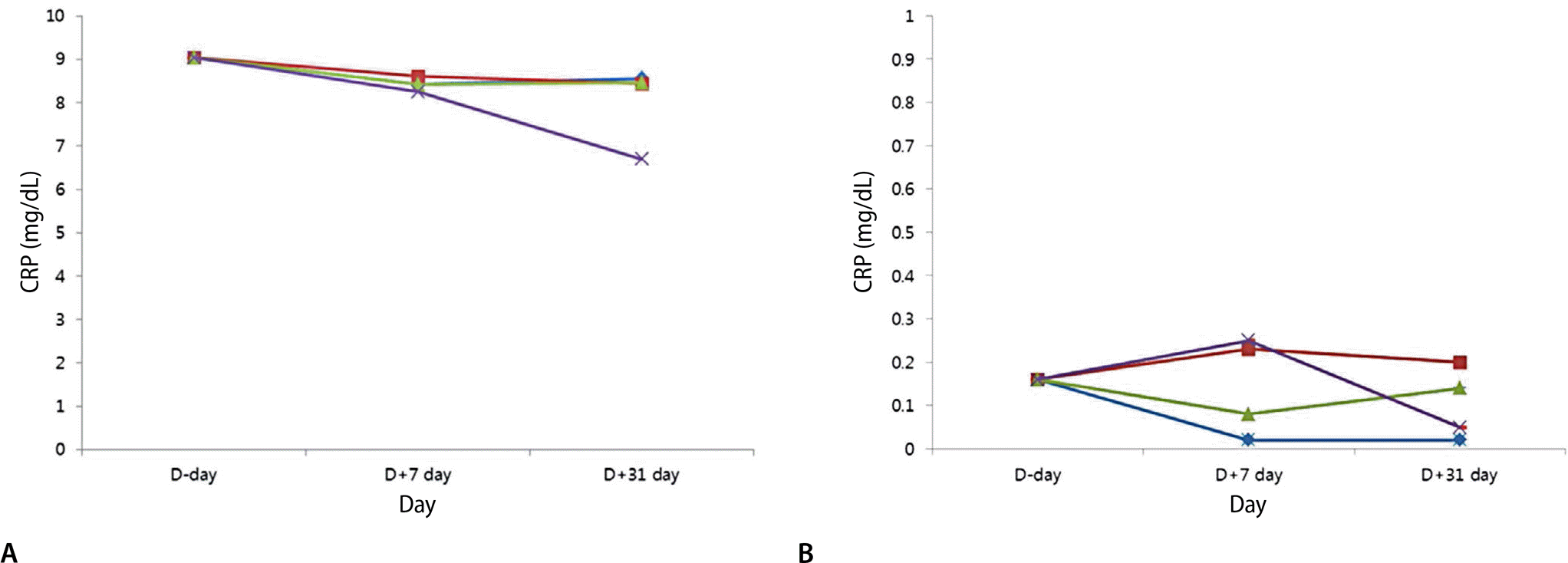Abstract
C-Reactive protein (CRP) is an acute phase response protein synthesized in the liver as a response to various inflammation. CRP is extensively used as a general marker for inflammation in clinical medicine. A forensic applications of the CRP using postmortem samples have been studied in oversea. We have compared CRP in the between antemortem and postmortem samples and studied stability of postmortem blood samples for CRP test. In 69 consecutive autopsy cases, we have analysed heart blood samples (69 cases), peripheral blood samples (33 cases), and vitreous humor samples (60 cases). Postmortem CRP was elevated in 25 cases (36.2%) and possible causes of CRP elevation were inflammatory disease except one case (unknown). Postmortem CRP test shows sensitivity 86.7%, specificity 80%, positive predictive value 92.9%, and negative predictive value 66.7% for inflammation based on 20 cases with antemortem CRP results. The postmortem CRP levels were similar in the heart blood samples and peripheral blood samples. Vitreous humor samples are not useful in postmortem CRP testing. And both whole blood and serum samples are stable in room temperature until 31 days. We conclude that serum from heart blood is best suitable sample for postmortem CRP test and postmortem CRP test is useful in routine autopsy practice to detect inflammatory disease such as sepsis. From the view of postmortem point, we desire that this valuable test should be used in routine autopsy practice in Korea.
Go to : 
REFERENCES
1.Astrup BS., Thomsen JL. The routine use of C-reactive protein in forensic investigations. Forensic Sci Int. 2007. 172:49–55.

2.Fujita MQ., Zhu BL., Ishida K, et al. Serum C-reactive protein levels in postmortem blood: an analysis with special reference to the cause of death and survival time. Forensic Sci Int. 2002. 130:160–6.
3.Tsokos M., Reichelt U., Jung R, et al. Interleukin-6 and C-reactive protein serum levels in sepsis-related fatalities during the early postmortem period. Forensic Sci Int. 2001. 119:47–56.

4.Lindroos-Jokinen K., Keltanen T., Vanhala T, et al. Postmortem measurement of C-reactive protein and interpretation of results in ketoacidosis. Leg Med (Tokyo). 2012. 14:140–6.

5.Na JY., Cho WY., Park JW, et al. Infective endocarditis: an autopsy case report with literature review. Korean J Leg Med. 2014. 38:78–82.

6.Na JY., Park JW., Oh YH, et al. Vibrio vulnificus sepsis: an autopsy case. Korean J Leg Med. 2015. 39:45–8.
7.Uhlin-Hansen L. C-reactive protein (CRP), a comparison of pre-and post-mortem blood levels. Forensic Sci Int. 2001. 124:32–5. S.
Go to : 
 | Fig. 1.(A) This graph shows postmortem C-reactive protein (CRP) level is decreased according to time of storage in positive result case. (B) This graph shows that the change of postmortem CRP is irregular in negative result case. (A, B) X indicates results of whole blood which was stored at room temperature; ▲ indicates results of whole blood which was kept refrigerated; ■ indicates results of serum which was stored at room temperature; ◆ indicates results of serum which was kept refrigerated. |
Table 1.
Cases of positive postmortem C-Reactive protein (CRP)
Table 2.
C-Reactive protein (CRP) concentration in antemortem and postmortem
| Case No. | Cause of death | PMI (hr) | tPMI (hr) | Antemortem CRP (mg/dL) | Postmortem CRP (mg/dL) | P-valuea) |
|---|---|---|---|---|---|---|
| 2 | PTE | 31 | 201 | 2.20 | 1.53 | |
| 11 | Sudden cardiac death | 28 | 118 | 8.70 | 5.39 | |
| 17 | Aortic dissection | 51 | 70 | 0.20 | 0.42 | |
| 29 | PTE | 49 | 123 | 3.93 | 0.73 | |
| 30 | Sepsis | 29 | 101 | 0.07 | 7.71 | |
| 35 | Sepsis | 38 | 61 | 17.94 | 14.90 | |
| 43 | Myocardial infarction | 24 | 100 | 0.05 | 0.01 | |
| 45 | Pneumonia | 39 | 82 | 8.53 | 15.90 | |
| 46 | Multiorgan failure | 64 | 181 | 2.40 | 0.77 | |
| 47 | Myocardial infarction | 51 | 76 | 7.37 | 6.75 | |
| 49 | Ludwig's angina | 32 | 96 | 17.8 | 9.04 | |
| 51 | PTE | 91 | 168 | 9.30 | 2.33 | |
| 52 | Poisoning | 38 | 43 | 0.11 | 0.12 | |
| 55 | Sepsis | 266 | 271 | 9.03 | 4.81 | |
| 56 | PTE | 29 | 76 | 10.29 | 8.97 | |
| 57 | PTE | 50 | 76 | 0.99 | 0.88 | |
| 58 | Multiorgan failure | 92 | 111 | 26.80 | 11.50 | |
| 60 | DCMP | 56 | 624 | 13.80 | 7.61 | |
| 61 | Myocardial infarction | 98 | 202 | 11.70 | 10.60 | |
| 63 | Multiorgan failure | 66 | 144 | 33.10 | 12.90 | |
| Total (mean±SD) | 9.21±9.13 | 6.14±5.22 | 0.13 |




 PDF
PDF ePub
ePub Citation
Citation Print
Print


 XML Download
XML Download